Paving is laying down durable materials like asphalt, concrete, bricks, or natural stone to create roads, sidewalks, and parking lots. It is essential in ensuring safe and convenient transportation infrastructure, facilitating economic growth and social inclusion.
Aside from its practicality, paving also offers an aesthetic appeal. It comes in various materials to suit different architectural styles, from concrete and asphalt to bricks and stones. Click the https://drivewaypavingcharleston.com/ to learn more.

The right paving materials can create attractive and functional outdoor spaces. Concrete paving is durable and versatile, offering a wide range of finishes, colors, and patterns that complement different architectural styles. Bricks and natural stones are also common paving materials, adding classic beauty and elegance to outdoor spaces.
The paving process starts with a solid base layer that provides support and prevents settling or erosion. Then, the chosen paving material is applied and compacted to create an even surface. Finally, final treatments like sealcoating and striping can be applied to protect against weather and wear.
Well-maintained pavements improve the aesthetics of residential and commercial properties and boost safety, functionality, and property values. When choosing a paving company, it is important to consider their reputation and reviews, licensing and insurance, and portfolio of past projects.
Professional asphalt paving is a cost-effective option that offers many design options to suit your aesthetics. It is flexible and resistant to damage from freeze-thaw cycles, heavy traffic, and harsh weather conditions, which can reduce maintenance costs and downtime. Asphalt is also available in a variety of colors and textures to complement your landscape and architecture.
Paved roads and highways provide reliable transportation infrastructure, promoting economic growth, trade, and commerce. They also improve road safety by reducing accidents, lowering vehicle wear and tear, and enhancing visibility and traction. Additionally, accessible paved pathways and ramps promote inclusivity and independence for pedestrians, cyclists, and people with disabilities.
Protection
Paved surfaces are a critical component of infrastructure, connecting homes, businesses, and communities. Proper installation and regular maintenance are necessary to ensure the quality, durability, and safety of paved areas. When a paved area begins to show signs of wear and tear, it can quickly become hazardous for pedestrians and vehicles, resulting in accidents and costly repairs. By implementing pavement protection measures, businesses can prevent damage and keep their customers, employees, and vehicles safe.
A paving sealer forms a waterproof layer over the surface of paved stones, protecting them from water and other contaminants. This helps minimize moisture penetration, which can lead to cracking and shifting of the underlying material over time. Paving sealers are also effective at blocking UV rays, which can cause fading and discoloration of the paving stones.
Depending on the type of paving stones, different types of sealers offer various levels of protection. For example, a solvent-based, high-gloss block paving sealer can enhance the color of stone pavers and protect them from oil spills and other damaging substances. It also provides resistance to freeze-thaw damage and helps prevent weed growth between the pavers.
Another common method of paving protection is slurry sealing. This treatment uses a mixture of asphalt emulsion, aggregates, and binders to create an effective seal over the surface of the pavement. It can also be used to repair and restore existing deteriorated asphalt.
The use of paved roads, streets, and highways facilitates the movement of people and goods, providing essential services and supporting economic development in communities around the world. Proper paving can help reduce traffic congestion and safety hazards while minimizing environmental impact. Pavement protection measures can extend the lifespan of paved roadways and minimize the need for expensive repairs and reconstruction. By maintaining the structural integrity of their paved surfaces through regular maintenance and protective treatments, businesses can minimize road closures, delays, and financial losses due to unreliable transportation infrastructure. This enables them to provide a smooth, safe, and convenient experience for their customers and business partners while demonstrating a commitment to sustainability and environmental stewardship.
Durability
Paving involves covering an outdoor surface with a durable material that can withstand traffic and weather conditions. Different materials are available for use in paving, including asphalt, concrete, bricks, and stones. Each type of material offers its own benefits and drawbacks when used for paving projects. Asphalt, for example, is a common choice for roadways and driveways due to its cost-efficiency and durability. However, it is important to choose a paving material that is suitable for your specific project.
The durability of paving is determined by its ability to withstand wear and tear, with factors such as the climate and the type of traffic impacting its lifespan. Proper construction and maintenance techniques are key to ensuring that your paving will last as long as possible.
When choosing a paving material, consider its aesthetics and how it will complement the overall design of your outdoor space. Concrete paving slabs are available in many different colors and textures to meet your design goals. There are also various shapes and sizes of pavers available, from squares and rectangles to hexagons and octagons. Paving stone can also be molded into unique designs, such as flowers or animal shapes, for added decorative appeal.
In addition to choosing durable paving materials, it is essential to plan for future replacement projects. Having a clear understanding of the expected lifespan of your concrete paving will help you implement a proactive maintenance schedule that minimizes operational disruptions and maximizes the return on investment in your infrastructure.
Achieving an optimal paving lifespan requires a strategic approach that includes meticulous inspections and timely interventions. Incorporating modern maintenance technologies such as infrared imaging and ground-penetrating radar empowers maintenance teams to identify underlying issues at their earliest stages, significantly reducing the risk of costly repairs and premature replacements.
A comprehensive paving strategy also incorporates planned replacement projects to minimize the impact of operational disruptions and minimize expenses. Investing in high-quality materials and expert installation may incur higher upfront costs, but it will reduce the need for frequent repairs and early replacements, ultimately lowering long-term expenditures.
Safety
Paving offers protection because unpaved surfaces are vulnerable to rough weather conditions which can wash off the sand that holds them together. This can cause the surface to be unstable, posing a safety risk and also result in costly repairs for the property owner. Paving prevents this by strengthening the foundation of surfaces which means that they are not likely to get damaged by harsh weather conditions.
The process of paving involves handling and using asphalt which poses certain risks to workers who are not properly trained. It is essential that workers receive safety training regarding the specific elements of each asphalt mix used, its boiling point and flash temperature, and proper handling procedures. It is also important that the training include information on personal protective equipment (PPE) as well as emergency procedures that need to be followed in case of fire or exposure to fumes.
Many of the hazards associated with asphalt paving are related to the heat of the materials and heavy machinery involved in the project. It is vital to keep all workers safe by ensuring that equipment is always in good working condition and following proper operating protocols.
Regular workshops are also an effective way to ensure that all employees understand the hazards associated with a particular pavement construction process. This can be as simple as a safety meeting for workers who work with asphalt and discussing the specific dangers.
Workers should wear all PPE recommended for their job, including safety glasses or a full face shield to protect the eyes from dust and asphalt fumes. Eye protection is necessary to prevent serious injuries like rashes and burns. If asphalt gets into the eyes, it is important to locate an on-site eyewash station and rinse immediately to avoid further injury.
Keeping the area secure from passersby is also essential to avoid accidents. This can be as easy as putting up signs and barricades to mark the work zone in a residential driveway or more complex if the work is being performed on an intersection or road. A thorough inspection of the entire project site is also important to identify potential obstacles, such as overhead power lines or buried utilities that could cause an accident. These obstructions should be clearly marked and blocked with barriers or marked with flaggers to prevent people from getting injured by navigating around them.








